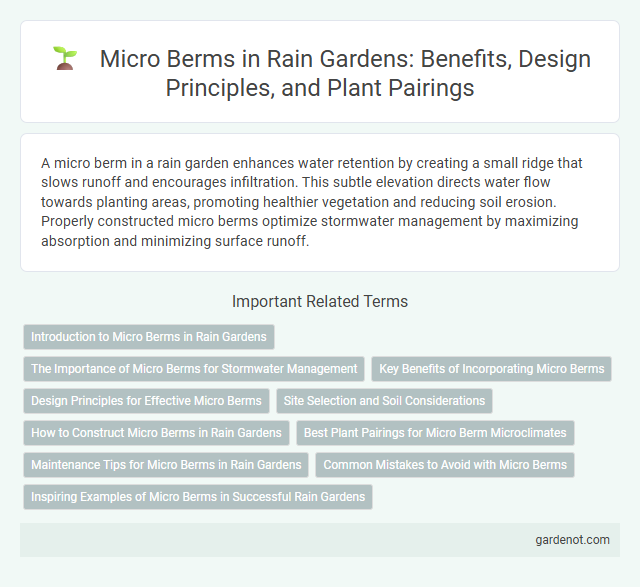A micro berm in a rain garden enhances water retention by creating a small ridge that slows runoff and encourages infiltration. This subtle elevation directs water flow towards planting areas, promoting healthier vegetation and reducing soil erosion. Properly constructed micro berms optimize stormwater management by maximizing absorption and minimizing surface runoff.
Introduction to Micro Berms in Rain Gardens
Micro berms in rain gardens are small, raised earth mounds designed to slow down stormwater runoff and enhance infiltration. These berms create micro-depressions that direct water flow toward planting areas, improving water retention and reducing soil erosion. Incorporating micro berms optimizes rain garden performance by increasing pollutant removal and supporting healthier plant growth.
The Importance of Micro Berms for Stormwater Management
Micro berms are essential components in rain garden design, enhancing stormwater management by directing runoff and promoting infiltration. These small, raised soil barriers control water flow, reduce erosion, and increase sediment capture, improving overall water quality. Their strategic placement ensures efficient distribution of stormwater, preventing overflow and maximizing retention within the garden system.
Key Benefits of Incorporating Micro Berms
Micro berms enhance rain garden performance by improving water retention and promoting deeper infiltration, which reduces runoff and erosion. These subtle elevation changes create diverse microhabitats, supporting a wider variety of native plants and increasing biodiversity. Incorporating micro berms also aids in sediment capture, improving overall water quality in urban stormwater management.
Design Principles for Effective Micro Berms
Micro berms in rain garden design function to slow water runoff and increase infiltration by creating subtle elevation changes. Effective micro berms incorporate permeable soils and native vegetation, promoting soil stability and reducing erosion. Proper sizing and strategic placement along contour lines maximize water retention and enhance the garden's filtration capacity.
Site Selection and Soil Considerations
Micro berms enhance rain garden performance by directing water flow and improving infiltration, making careful site selection crucial to their effectiveness. Optimal soil conditions include well-drained loam or sandy loam soils with good permeability, avoiding compacted or poorly draining clay soils that impede water absorption. Properly assessing soil texture, structure, and infiltration rates ensures the micro berm supports runoff management and prevents erosion within the rain garden.
How to Construct Micro Berms in Rain Gardens
Micro berms in rain gardens are constructed by shaping small, raised soil ridges around the perimeter or within the garden to redirect runoff and promote water infiltration. Begin by compacting soil to form berms approximately 4 to 6 inches high and 6 to 12 inches wide, using native soil mixed with organic matter for stability and nutrient retention. Position micro berms strategically to slow water flow, enhance sediment capture, and support plant growth by creating microhabitats for moisture-sensitive species.
Best Plant Pairings for Micro Berm Microclimates
Micro berms create unique microclimates ideal for diverse plant pairings that enhance rain garden performance. Native grasses like Blue Fescue and Carex species thrive alongside moisture-loving perennials such as Sedum and Echinacea, ensuring erosion control and habitat diversity. Combining drought-tolerant shrubs like Lavender with shade-tolerant ferns optimizes water retention and promotes resilient biodiversity within the micro berm environment.
Maintenance Tips for Micro Berms in Rain Gardens
Micro berms in rain gardens require regular inspection to ensure soil stability and prevent erosion, especially after heavy rainfall. Periodic removal of sediment buildup and invasive weeds helps maintain optimal water flow and plant health. Applying mulch around the micro berm supports moisture retention and reduces weed growth, enhancing the garden's overall sustainability.
Common Mistakes to Avoid with Micro Berms
Micro berms often fail due to improper height, which can cause overflow or poor water retention, undermining the rain garden's effectiveness. Using unstable soil materials or neglecting compaction leads to erosion and berm collapse, compromising stormwater management. Avoid positioning micro berms too close to structures or utilities to prevent water damage and maintenance challenges in the rain garden system.
Inspiring Examples of Micro Berms in Successful Rain Gardens
Micro berms in successful rain gardens create subtle elevation changes that enhance water flow control and promote effective filtration. Notable examples include the Portland Ecoroof, where micro berms direct runoff toward native plants, and the Chicago Riverwalk garden, which uses them to reduce soil erosion while maximizing water infiltration. These installations demonstrate how strategically placed micro berms can improve stormwater management and support sustainable urban landscaping.
Micro berm Infographic

 gardenot.com
gardenot.com